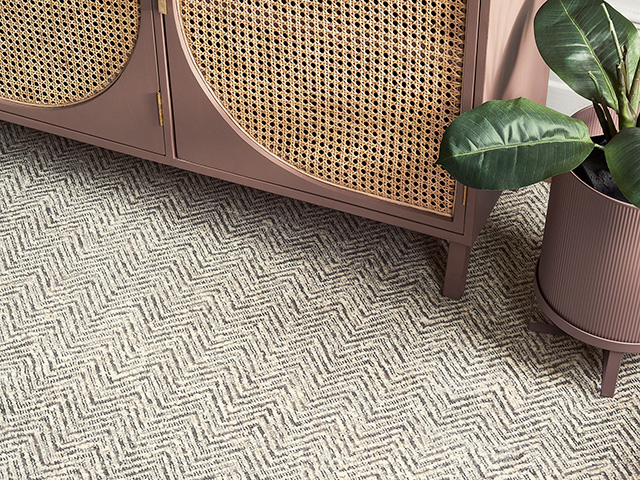
Carpet: which type is right for your home?
While hardwood floors my be becoming more and more popular in homes, you really can’t beat that soft, sinking feeling of a luxurious carpet underfoot. Carpets, despite what you may think, can be incredibly durable, hardwearing and stain-resistant, if you choose the right style for your space. From its fibre make-up to the style of pile and durability, Good Homes helps you make the right choice for each room of the house…
Carpet fibres
Get your fibres right and you’ll be on the path to better carpet for your home.
Polypropylene carpets
These manmade carpets are not only incredibly tough and hardwearing (you can even clean stubborn stains with bleach), they’re super soft too. This makes it a good all-rounder for anywhere in the house. Plus, this is one of the most budget-friendly carpets around.
However, some polypropylene carpets can flatten, especially in high traffic areas such as hallways. Also, it’s important to remember that polypropylene is a plastic, which raises environmental and sustainability issues.

Firework Gleam from Lifestyle Floors is a budget friendly polypropylene carpet
Nylon carpet
Another manmade carpet, Nylon is more likely to bounce back underfoot than polypropylene, but is still a durable, soft option. It’s worth remembering that manmade carpets don’t have the natural thermoregulatory properties of natural materials like wool, meaning it will feel cold underfoot in winter, warm in summer and can store humidity in the air as damp.
Wool carpet
A popular fibre choice, wool is a natural, sustainable choice for the home, but it also has some key benefits for use as a carpet. It’s durable, bounces back underfoot and is easy to clean. It has the benefits of a natural look when used in its raw form, but it also holds colour better than manmade alternatives. Wool flooring also provides natural insulation, of both heat and sound.
Thanks to all this, wool can be a more expensive choice for the home, but as it should last a long time, it’s a worthy investment. Wool blend carpets can be less expensive and combine the core benefits of both wool and manmade carpets.
Sisal, seagrass and jute
Carpets made from natural grasses have a natural look and are super tough underfoot. They may not be the softest of styles, but for the right space and to achieve a certain look, they’re ever popular choices for the home.

The Sisal Panama carpet from Kersaint Cobb has a lot of natural character
Carpet piles
The choice of fibre is only half the story when it comes to your carpet – how those fibres are used to create a rug is of equal importance. By and large, there are two types: cut and loop pile carpets, but with a variety of styles in between.
Twist
Like many cut piles carpets, the fibres of a twist carpet have been heat sealed, so that you can see the individual fibres that the carpet is made up of. Twist carpets have fibres that twist in different directions. This means that the fibres catch the light at different angles and are more irregular, offering a less uniform look. All this means that you won’t notice furniture foot marks or track marks from the vacuum cleaner, and it’s less likely to flatten.
Saxony
A Saxony carpet is the opposite – all of its fibres are perfectly straight and aligned, meaning that while you will see more disturbance in the fibres with everyday use, you get a super deep, soft carpet underfoot. This carpet is best used in spaces that have less footfall, and where you’ll appreciate that soft touch, such as the bedroom.

A plush Seymour Saxony carpet in Almond from Carpetright
Velvet
Velvet carpets are a short cut pile carpet which have not been heat treated, meaning that the fibres do not hold together individually. Rather, they fray and expand to create a dense, uniform top layer to the carpet. As the name suggests, this carpet is the epitome of softness, however, it’s far less durable that heat treated fibres, so should only be used in areas with lesser footfall.
Loop
As loop carpets have fibres that are fully intact, they’re extremely durable, with lesser chance that fibres will fray or unravel, so perfect for high traffic areas. The loop structure means that these carpets are bouncy underfoot, though not as soft as cut pile carpets, and create an inimitable texture for the floor. Loop carpets may not be best suited to homes with pets, and claws can easily get caught in the loops, leading to damage to your floor covering.

Alternative Flooring’s patterned carpet ranges are Axminster woven, helping to create a crisp pattern. This runner is made in Quirky Ella Doran Camo Blu
Cut and loop
As the name suggests, cut and loops carpets contain both kinds of fibres, which can be used to create decorative patterns in the carpet. This style was a popular choice in the 70s and 80s in more decorative styles, but it still has some uses today for more subtly textured carpets.
Berber
A Berber carpet is a loop pile with loops of different heights and sizes. This creates a super textured, but natural look.
Woven
Woven carpets are made in a very different way from all the tufted carpets above, but this means that they can last up to 20-30 years. This also makes them much more expensive, with woven carpets like Axminster certainly setting you back a pretty penny.

Woven herringbone Desert Oasis carpet from Lifestyle Floors Decades collection




